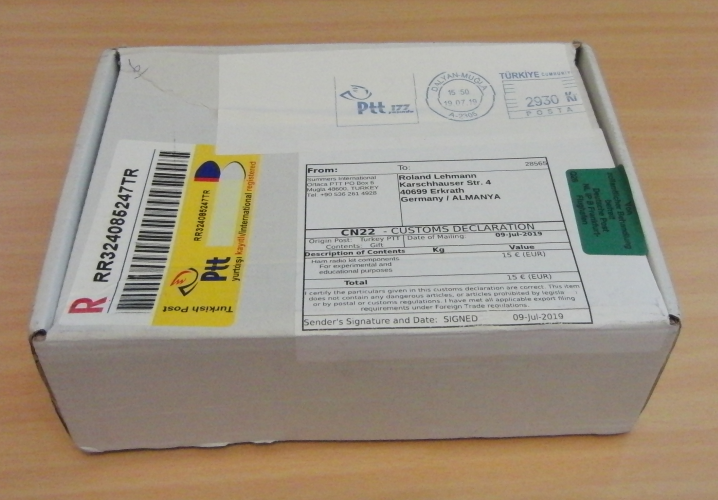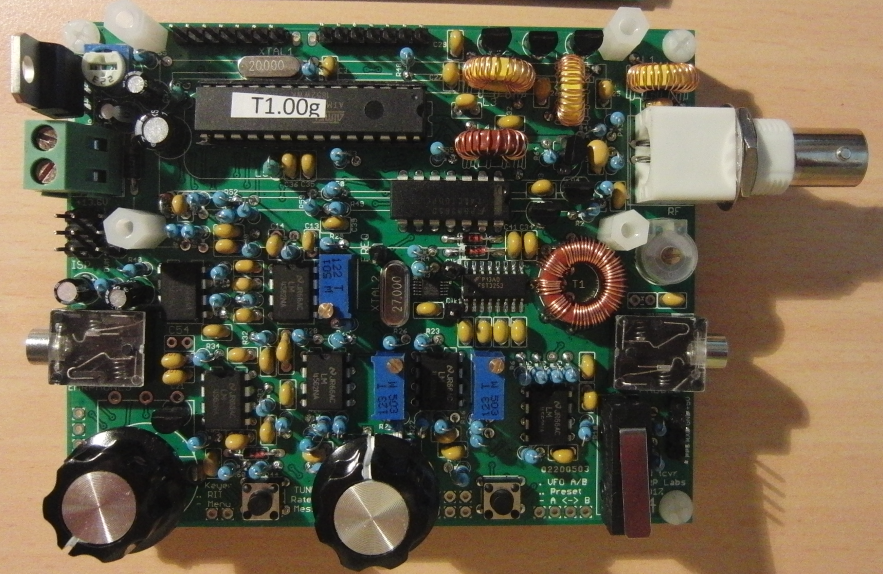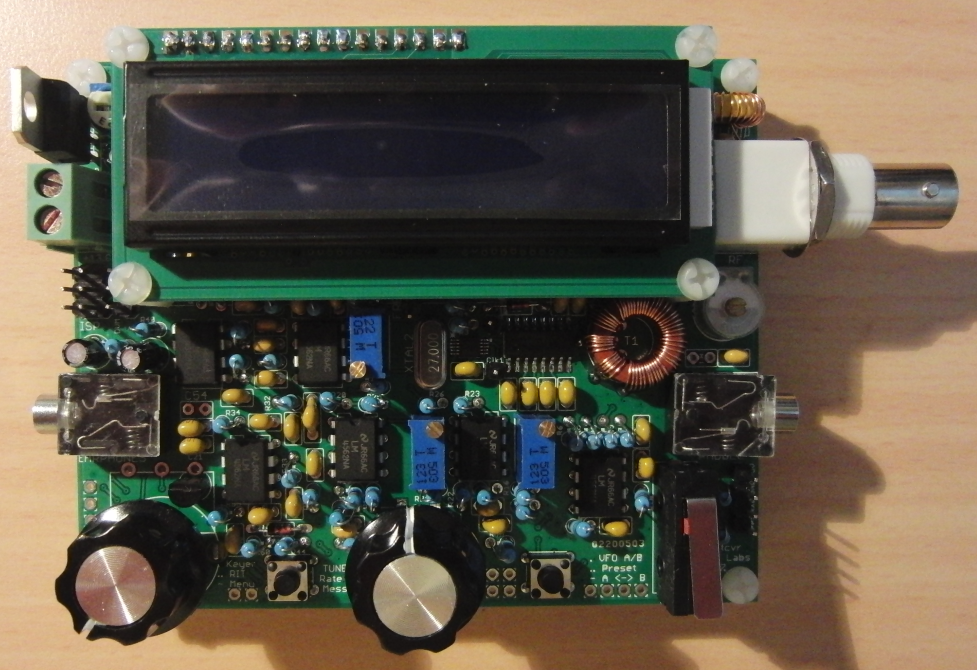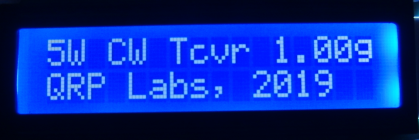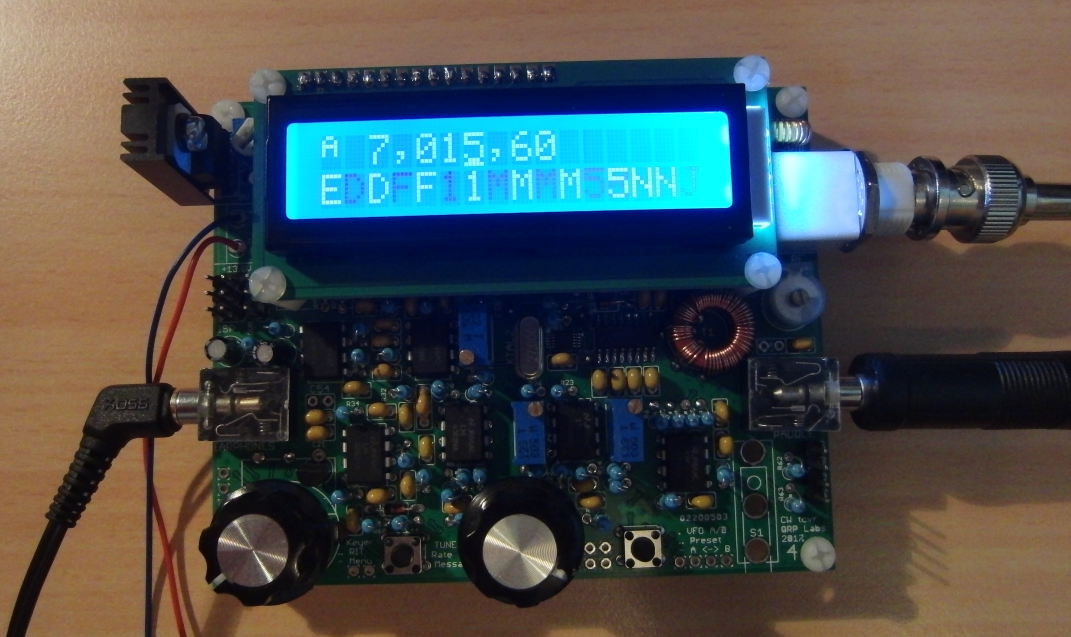|
A positive perception was the sensitivity of the receiver. Stations most distance I could hear during the contest were a couple of US and Brazilian callsigns and JT5DX from Mongolia. Not so bad!
The first negative impression was, the QCX obviously does not have an AGC, an automatic control of the HF or AF gain. If I had previously tuned to a station with weak signal and had turned up the volume potentiometer a little bit, and then moved the VFO frequency to a strong signal, the acoustic receptors of my ears got into acute mortal danger. The QCX seems to require one hand at the volume potentiometer at all times while you are moving through the band.
Second, the 200 Hz CW bandpass filter turned out to be free of ringing, but not particularly narrow. Well OK, this is not a high-tech crystal filter but just an RC circuit based filter in the AF stage. I admit, I’m used to know better filtering in my main station Transceiver (Elecraft K3S) with DSP and multi-crystal roofing filters. Anyway, in the 40 m band crowded by lots of contest stations I could also hear signals which were more than 500 Hertz away from the current VFO frequency. So the better filtering of CW signals has often to be carried out by the operator ears.
The CW decoder works in a way that you can read the decoded text as a ‘ticker’ in the lower row of the LCD display. The decoder quality is no better and no worse than all CW decoders that I know so far. If the morse coding of the received station is bad, or if QRM / QRN / QSB are deteriorating the receive quality, the decoder performance is quite limited. After all, the best CW decoder is the brain of the well-trained CW operator.
In other respects, the QCX transceiver, due to the utilization of the large storage space of the ATMega processor, has an enormous quantity of adjustment items in its extensive menu structure. This menu structire definitely can be compared to the big and expensive amateur radio transceivers. Nevertheless it only has four control elements, specifically the volume pot, two pushbuttons (Select and Exit) and a VFO knob (rotary encoder with an additional pushbutton function). The menu functions, in contrast, consist of 9 main levels, each with up to 13 sub-levels. So it is good to know there is an Operation Reference (aka ‘Cheat Sheet’) in the operator’s manual. This is one DIN A4 formatted page, which I recommend you should print out and always keep at hand, at least while you are in the training phase.
Now to th technical details of the QCX: The genius of this brilliant product is Hans Summers, GØUPL. Originally this kit was planned for the RSGB Youngsters On The Air (YOTA) summer camp event in August 2017, and it should evoke the interest of young persons in Amateur Radio and electronic DIY projects. The interest of the Amateur Radio community was indeed tremendous, and it expanded substantially beyond this YOTA event, in a way that, in the meantime, more than 7000 (!) kits of the QCX have been sold worldwide. Just take a look at the technical features:
- All components on a single PCB
- Professional double sided circuit board, 10 x 8 cm, with component silkscreen
- Output power 3 .. 5 Watt, depending on supply power voltage (7 – 16 V)
- Class E final power amplifier, with high efficiency and without heat sink
- An efficient low-pass filter to achieve suppression of harmonics as required by the legal commandments.
- CW pulse shaping to suppress key-clicks
- Outstanding receiver performance with more than 50 dB sideband suppresson
- 200 Hz CW Filter, with no ringing
- Direct digital synthesizer based on the state-of-the-art Si5351A chip
- VFO tuning by means of a rotary encoder
- LCD display with 2 lines of 16 characters
- Built-in keying circuit for iambic paddle and optional operation with standard manual key
- DSP based CW decoder with real-time display
- Signal generator, multimeter, frequency counter built-in to support the alighnment process
The receiver design, in summary, is based on direct conversion by means of a Quadrature Sampling Detector, (QSD), also known as Tayloe Detector or "IQ-Mixer". This design was, among others, applied in the early versions of the Flex Radio SDR transceivers. It is known for good selectivity and low signal losses. The QSD provides two AF signals (I & Q), which are shifted by exactly 90 degrees. These are fed into a phase shifting network, each one consisting of two 1:4 high-speed multiplexers and OPAmps, which suppress the unwanted sideband. In the following AF stage an audio filter with a bandwidth of 200 Hz and an audio amplifier drive the headphone output.
The VFO is built around the Si5351A chip with an external crystal controlled refence oscillator. This chip contains no less than three digital PLL circuits which are controlled by an ATMega328P microprocessor.
In the transmit circuit, the CLK2 signal of the Si5351A chip is first amplified to a level of 5 Vpp by two sequenced NAND gates. These feed three N-channel MOSFET transistors in parallel circuit. This final transmit power amplifier stage, consisting of cheap low-level transistors, is designed for class-E operation and operates in switching mode with square wave signals. The efficiency of this amplifier stage is near 90 percent. This design produces very low heat dissipation but is also capable to produce a lot of harmonic waves. In consequence, we don’t need a heat sink, but some effective harmonics suppression is absolutely necessary. This is done by a 7-element low-pass filter. So the BNC antenna socket supplies about 3 to 5 Watts of transmit power, depending on the supply voltage.
In conclusion I can say, for about 50 Euros you are getting a very good QRP-Transceiver, which, besides a few restraints, does an excellent job. The assembly requires some practice and good workmanship, which after all are rewarded with good receiver performance and a lot of fun on the air.
Not long ago, QRP Labs announced a new development, the QSX transceiver, which is said to be a 10 Watt all-band transceiver, featuring not only CW mode but also SSB, RTTY, PSK etc. The transceiver kit would be in the range of about 150 US Dollars. I sure will keep an eye on this.
|


